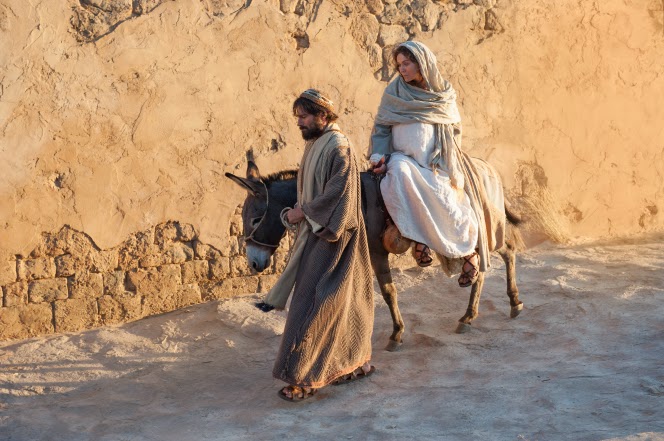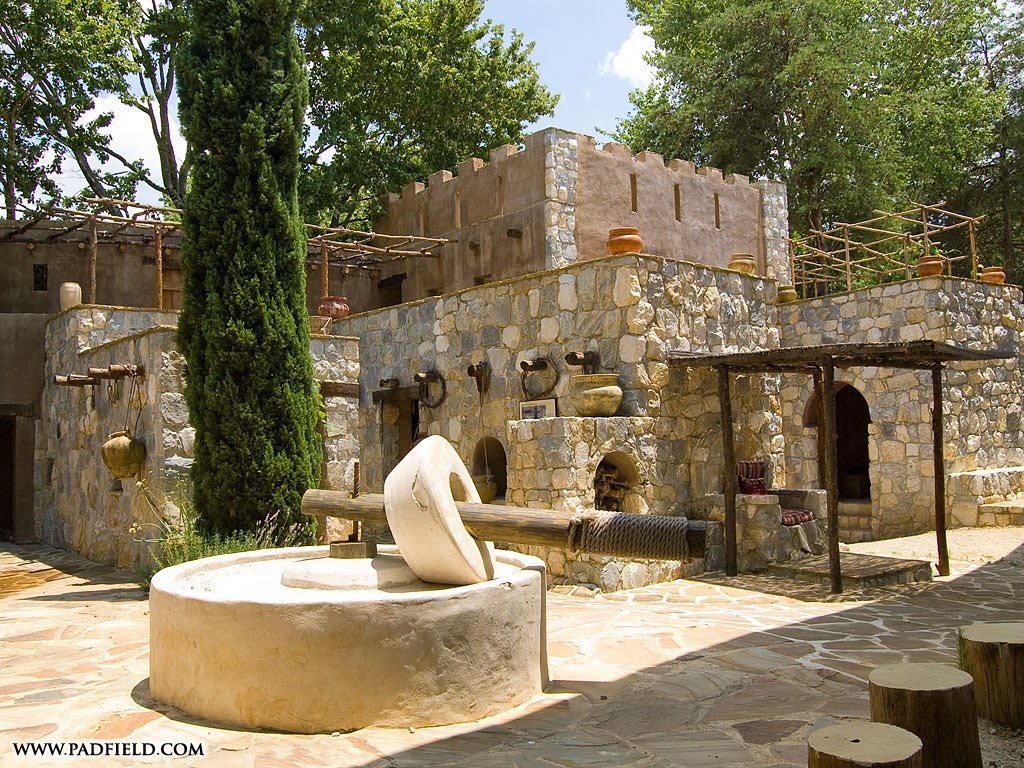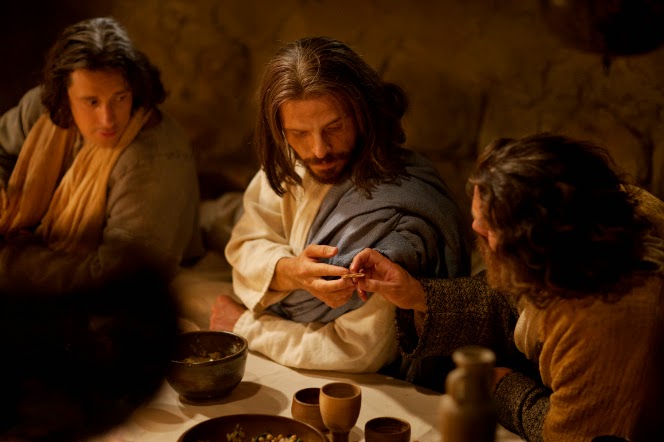This Christmas season my heart is a jumble of so many thoughts about Mary. I’ve spent the last year writing about her, dreaming about her, thinking about her, and pondering on all the women and men she would have known in mortality. The more I learn about her the more astounded I am by the woman she was.
Yet, there is something small I learned this year as I was studying Mary that really impressed me. It has to do with the story of the Nativity. In Luke 2: 6-7 it reads:
It is the word that is translated as “inn” that interested me. The word in Greek is “kataluma” and it has several meanings and usages including, ” an inn, a lodging place, an eating room, and a dining room” (source). This means that the “inn” may have referred to a public lodging house, but it also could have been a guestroom in a private residence. In fact, many house did have a guestroom, which often was the upper room of the house. This was the room of the house
that was literally above the rest of the house and was usually reserved for guests or important meetings.
Most interestingly, is that the ONLY other place that the word “kataluma” is used in the New Testament is to refer to the “upper room” that Jesus and His apostles met in for the Last Supper. In Mark 14: 14 (and also in Luke 22:11) the word “kataluma” is used when Jesus instructs the apostles to secure a room for the passover. It reads,
“13 And
he sendeth forth two of his disciples, and saith unto them, Go ye into
the city, and there shall meet you a man bearing a pitcher of water:
follow him.14 And
wheresoever he shall go in, say ye to the goodman of the house, The
Master saith, Where is the guestchamber [kataluma], where I shall eat the passover
with my disciples?
In this usage “kataluma” is clearly the guestroom of the house, which makes me suspect that the same was probably true of the “kataluma” where there was no room for Mary and Joseph.
I found a great website of a re-constructed New Testament house that can help you understand it better. Many New Testament houses would probably have looked something like this.
The bedrooms and living quarters (including the guestroom or “kataluma”) would have been on the upper levels. The kitchen was often outside and the bottom floor of the house (what in this picture is the stone archway) would have been something similar to our modern day garages, where things would have been stored. Instead of a car inside though, it would have been the donkey and the cart. Other animals, like chickens, sheep, and goats would also have been kept on this lower level of the house.
It is interesting when we look at New Testament house like this, and remember that Joseph would have had a lot of family in (and traveling to) Bethlehem, how our idea of Mary and Joseph rushing through crowded streets trying to find a place to stay might not be exactly correct. First of all the text tells us that “while they were there” Mary went into labor, which makes it sound like they had been in Bethlehem for awhile, not rushing to find a place to stay.
Second, I think given the culture of the time it makes more sense to think that Mary and Joseph, who probably would have made the 67 mile trek from Nazareth to Bethlehem in the company of family, were welcomed into the home of one of Joseph’s relatives rather than a public house. Then perhaps, because the house was overflowing with extended family, there was no room for them in the “kataluma”, they were obliged to sleep in the lower level of the house, with the animals. We might even speculate that Joseph’s relatives could have been trying to give Mary more privacy by having her labor and birth in the “stable”, where she would have had much more room to move around than else where in the crowded house.
It is impossible for us to know what really happened the night Jesus was born but I like this version of the Nativity much better than I do the way we traditionally tell it. Traditionally we make it sound like the Inn Keeper (who isn’t mentioned in the text) was a bad guy who forced a pregnant woman to give birth in a degrading and desperate situation.
It changes things for me when I think about Mary giving birth to baby Jesus in a home, surrounded by family and people to give her support. She still would have given birth in less than ideal conditions and in very humble circumstances, but thinking of it this way helps me imagine what an incredible, beautiful birth it must have been to witness.
Regardless of where Jesus was actually born it still impresses me that the only two places the word “kataluma” is used in the New Testament are in the stories of the preparation for Jesus’s birth and in the story of Jesus’s preparation for the sacrament.
There was no place for Him in the “kataluma” when He was born. Yet, thirty-three years later it would be in a “kataluma” where He would first institute the sacred work of the sacrament– the emblems of His body and His blood that make it possible for us to be re-born into God’s kingdom.
I’m still trying to get my mind and heart around what exactly that means. But somehow that word “kataluma” links the event of Christ’s birth to the event of the sacrament, atonement and resurrection– two miraculous birth stories. And it reminds me that this Christmas season is celebrating the birth of the One perfect man, the One whose life made all lives worth living. The One, who through His birth, His death, and His re-birth, made it possible for us to never die… and that is definitely worth celebrating.












Yup. I totally agree. 🙂 http://birthfaith.org/midwives/away-in-a-manger
You actually commented on my post when I originally posted this on my old blog in 2009. 🙂 http://birthfaith.blogspot.com/2009/11/away-in-manger.html
So lovely the way you have linked kataluma the only two times it is used. Another reference to alpha and omega, the beginning and the end. It also brings to mind the passage Moses 6:59,
"That by reason of transgression cometh the fall, which fall bringeth death, and inasmuch as ye were born into the world by water, and blood, and the spirit, which I have made, and so became of dust a living soul, even so ye must be born again into the kingdom of heaven, of water, and of the Spirit, and be cleansed by blood, even the blood of mine Only Begotten; that ye might be sanctified from all sin, and enjoy the words of eternal life in this world, and eternal life in the world to come, even immortal glory;"
Serendipitous…I was just reading about this last night. The only thing about the traditional way of telling the story that really seemed to fit, though, was the symbolism behind there being "no room in the 'inn'" for the Christ-child. Truman G. Madsen described it more of a "heart condition" than a "space condition." Interesting is the old Rabbinical saying that the child born in the "inn" (kataluma) belongs to the people of the inn (they give the child gifts, etc) The child born in the palace belongs to the kingdom, and the child born in the stable belongs to everyone.
I am gearing up to read your book. I am especially looking forward to reading about the Mosaic purification laws that you mentioned would be included.
Wow what an amazing insight. I can't wait to share this with my family.
Heather
What a wonderful train of thought and info. I did some further research and it seems that there are many Temple references and symbols in both of these passages. Especially the "upper room" as a symbol of a place that is lifted high and above such as a mountain/temple.
In preparing the disciples for the Passover meal, Jesus first washed their feet. This is a reference to Moses preparing Aaron to enter the temple by washing and anoiting him, and placing clean temple clothing upon him, declaring him "clean every whit". The washing and anointing of the feet would have been in a separate room from the "dining" area.
The symbolism of Jesus siting at the table "in the midst" of them, as High priest,preparing the sacrifice.As he prayed and broke the bread and poured the wine Jesus made a covenant of "friendship" with his disciples or a "blood covenant" where the bread and the wine were symbols of the new "testament" of his blood and body that was given for us.. He gave "new" commandments of Love the Lord your God with all of your heart and love your neighbor as yourself. In great symbolism of that moment, was that Jesus was the Temple.
Matthew 12:6:8
6 I tell you that something greater than the temple is here.
8 For the Son of Man is Lord of the Sabbath.”
Thanks Heather
So interesting! Yes there is a lot of temple symbolism with the upper room. It is even interesting to note that in modern days the first temple ordinances were recieved in the "upper room" of the Red Brick Store! SO much cool symbolism.
There's a show currently on Netflix about the birth of Christ (produced by the Smithsonian channel) that talks about that exact thing. They also point out other discrepancies between what is typically thought of as the nativity and what is actually talked about in the biblical texts. I honestly didn't love the show because I don't think that the discrepancies detract from or discredit our beliefs, the important thing was that he was born. But I did find it interesting that it was most likely a family house rather than an inn, and it was interesting to see footage of what is thought of as a typical house at the time. I love how you linked it with the last supper. Interesting to think about!
The whole "Jesus being born in a stable" thing never made much sense to me. As a rather practical child I always thought that Mary and Joseph must have been tresspassing if they just found some random person's stable (with their animals included, so it couldn't be abandoned) to have Jesus in. This version makes much more sense. The Luke 2 video we grew up on obviously got it all wrong.
I was always told it was the innkeeper's stable that he offered when he ran out of room.
Ha! I love it.
I've always wondered how, if Joseph was of the House of David, did he end up in Nazareth? Also, do you have a particular reference guide or study Bible for Greek words?
I'm probably going to mix this up, but I think the tax city related to Joseph's side, while the David line was through Mary.
I'm not sure how they ended up in Nazareth, except that Galilee was a HUGE area for trade and merchants, so maybe they migrated that way for work. Both Mary and Joseph were of the house of David– they were cousins– but only the man would have been counted for tax reasons.
Oh, silly me, I was thinking you (Atomic Mom) were asking about where they went to be taxed, not where they were living. My bad!
The Joseph Smith Translation changes "inn" to "inns." How or does that change anything for you? Maybe just multiple guest rooms? I agree with you and the history show; this makes a lot more sense.
Interesting! I don't think it changes it at all. It is more likely that there were multiple guestrooms (among David's family) rather than multiple Inns in a small town like Bethlehem. People didn't often stay in what we would think of as Inns or Hotels, they mostly stayed with family, or relied on hospitality to take them in. So I still think the other understanding is probably correct, especially based off of the way the word is used else where in the New Testament.
Yes, this is how we tell the story too. I have had to caution my kids not to be argumentative when they see living nativities however! We are always learning and it's so hard to know what really happened in our next-door neighbor's house, much less a house, a culture and 20 centuries removed. Still, so good to share another view for people to consider. Our myths help us each in different ways. I like how you've offered this so respectfully.
I feel silly asking this question because it must be obvious to other people, but why the assumption that Joseph had family with whom to stay in Bethlehem? Because they had to go to their "hometown" to be taxed?
To add further confirmation to your story and research: in the Hebrew Scriptures it is termed Living Quarters' (no more space for them in the living quarters)
Additionally, they were headed to be registered in the Census. This is why I teach from the Hebrew bible that has the old and new testaments. Each family had to be registered especially those who were newly espoused. This is why he traveled there as the Head
I love this post!! Thankyou for giving me a new perspective on the Christmas story.
Such a great reminder that no matter how familiar the story, further study can bring more insight. Loved the connection. I think you would enjoy the nativity chapters at the beginning of ben hur. I just read it for the first time this year and love how he pictures the details of the nativity and the stories of the wise men. Thanks for all your writings!
I think you would like the Brian Kershisnik nativity with the midwives there. It makes much more sense to me that Mary would have been helped by other women. http://pomomusings.com/wp-content/uploads/2009/01/nativity.jpg
Then again, my sister much prefers thinking that only Joseph and perhaps angels were there to assist her. I think the important thing is knowing that Mary would have been surrounded by love and supported during her delivery by angels on earth or angels in heaven.